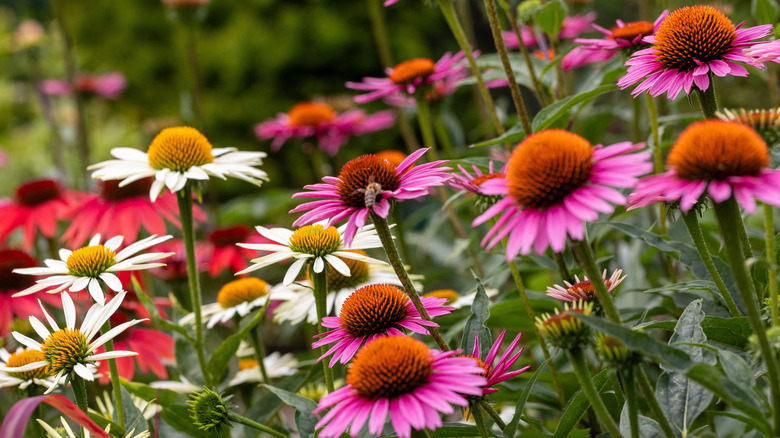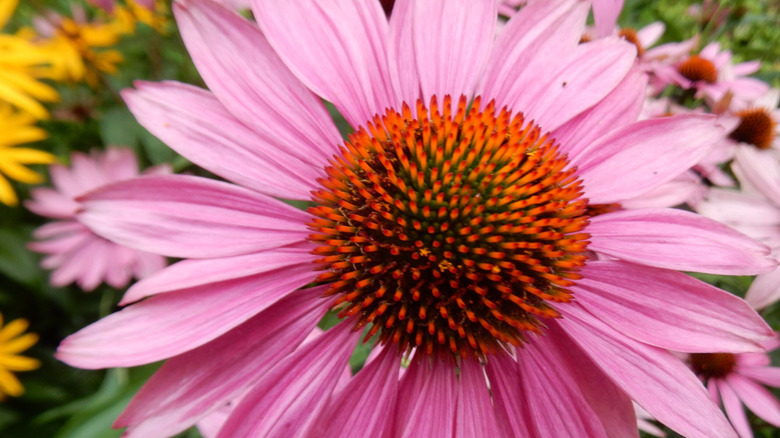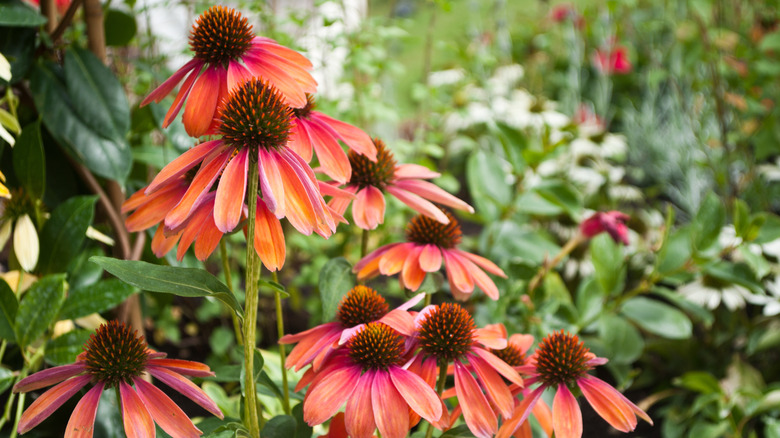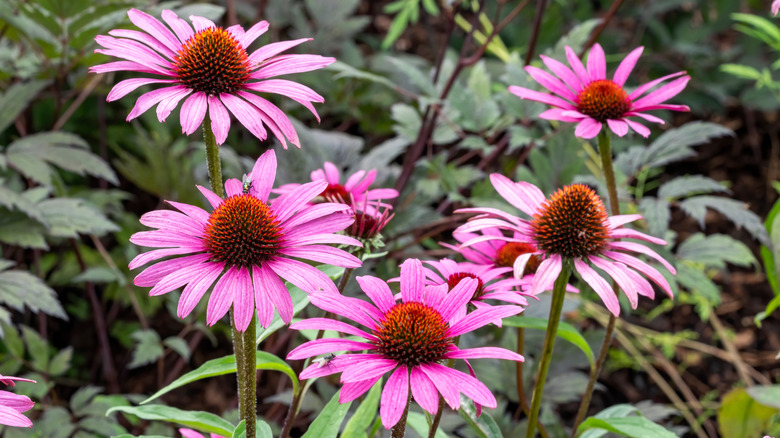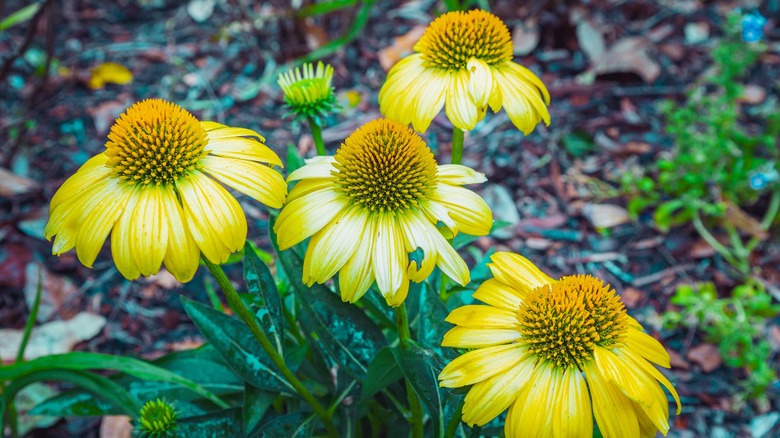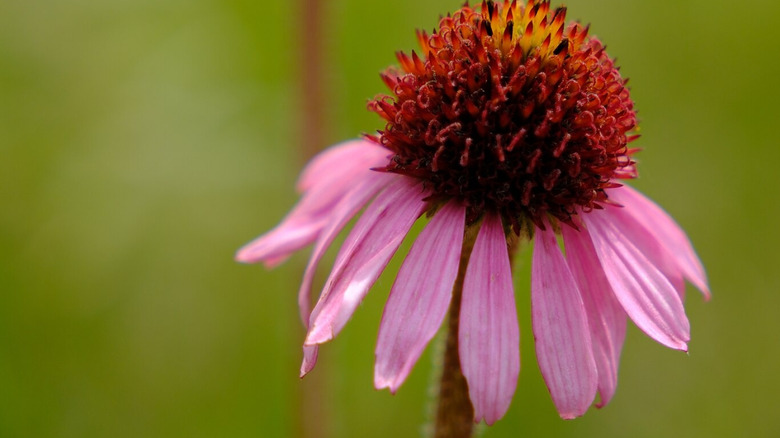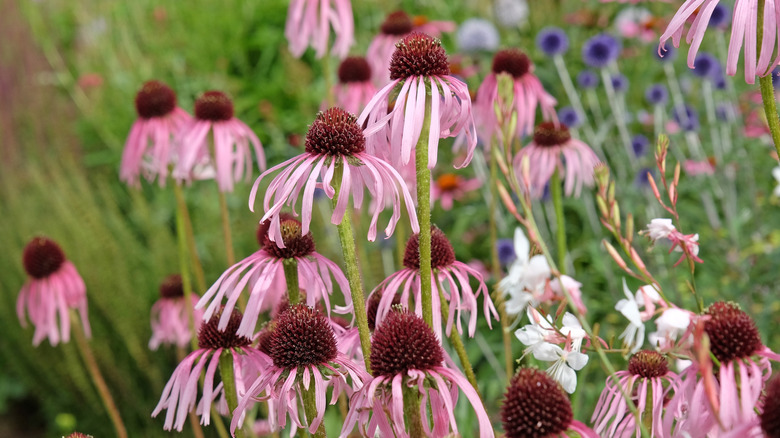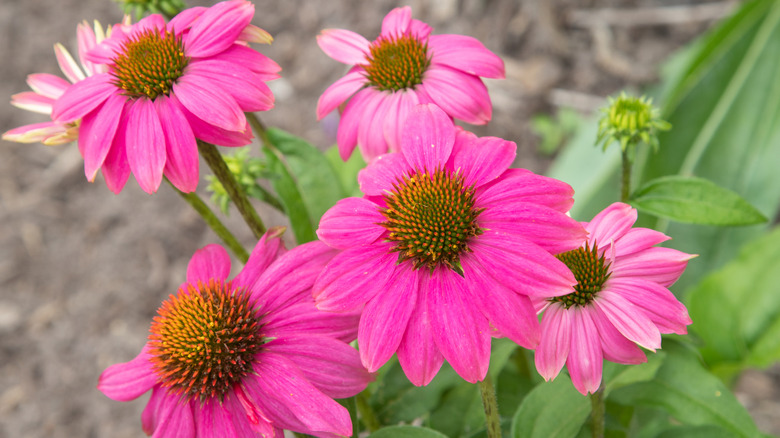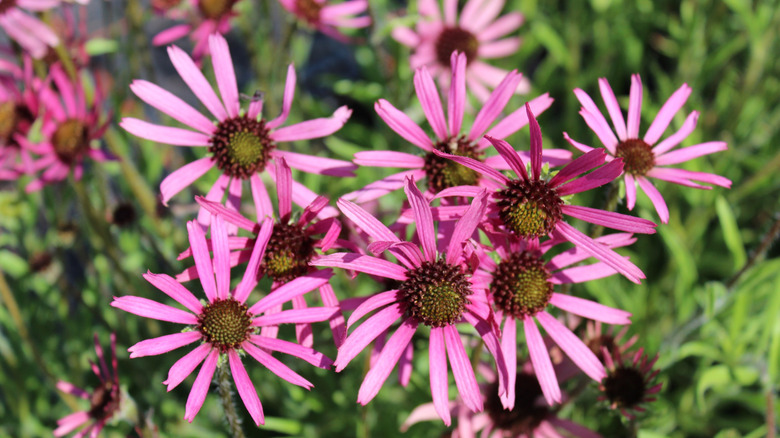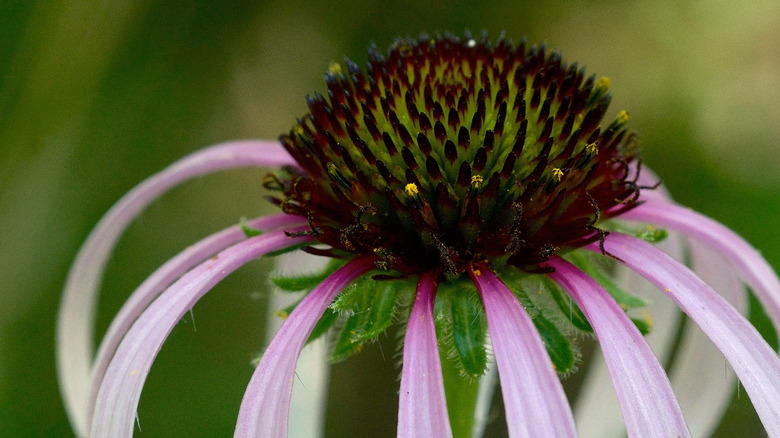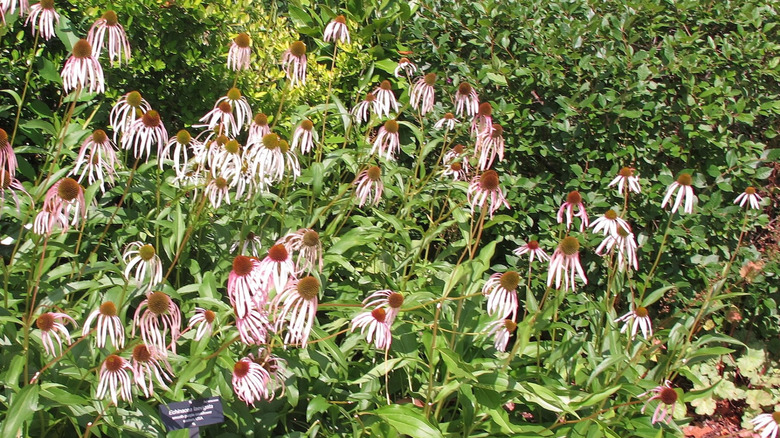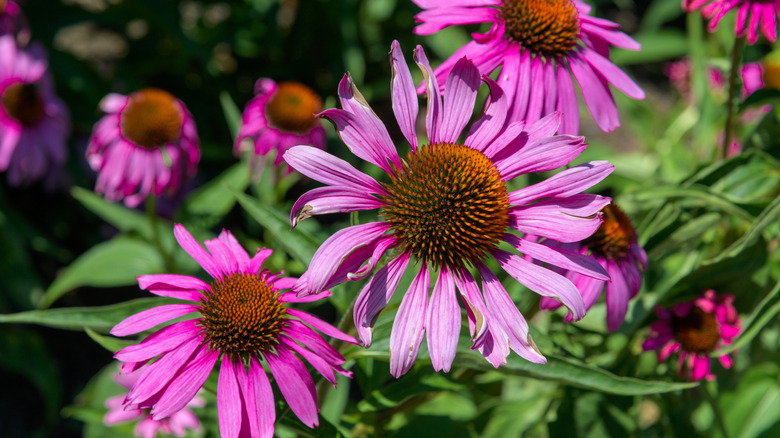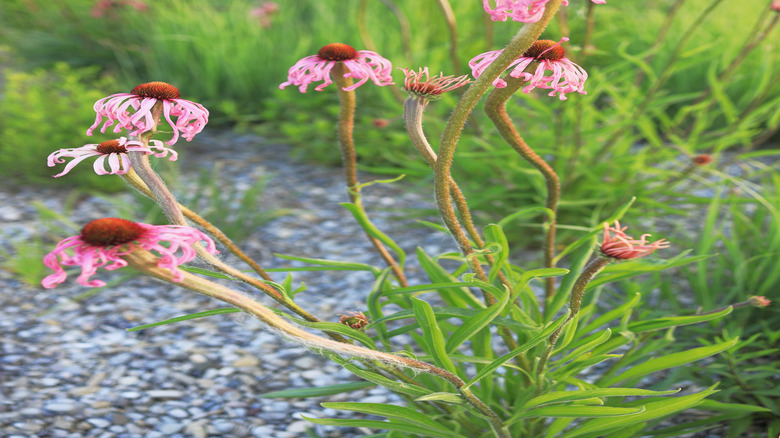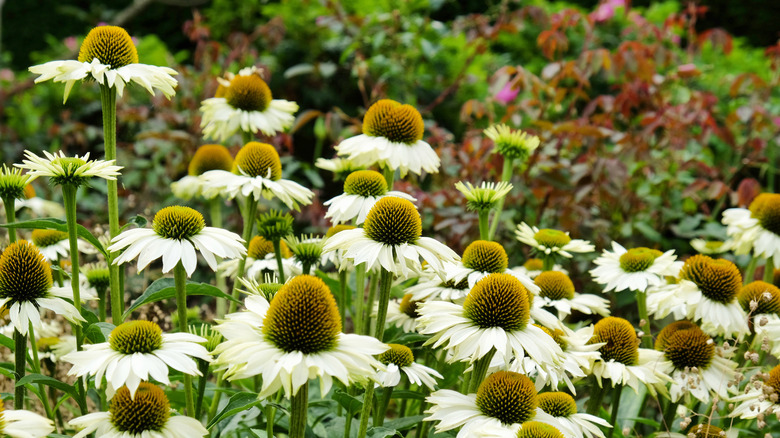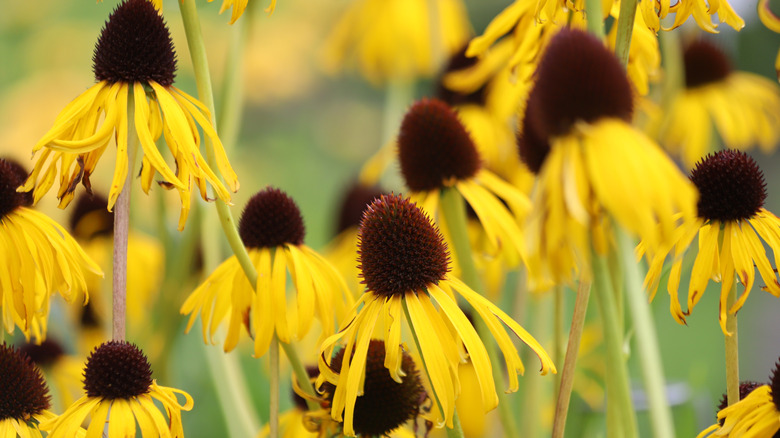15 Varieties Of Coneflower You Can Grow From Seed For A Budget-Friendly Garden
With its daisy-like petals and distinctive cone-shaped centers, the coneflower (Echinacea spp.) is the star of many a nature-forward yard, as well as the number one flower you should be adding to your chaos garden. These eye-catching wildflowers attract butterflies and birds — and they are easy to grow from seed in a budget-friendly garden, making coneflowers a good choice for beginner gardeners.
The coneflower world abounds with different flower colors and varying petal types, including many different species and even more cultivars – and multiple types of coneflower can be combined in the garden or yard for a glorious effect. There's a catch, though. While saving seeds is a budget-friendly trick to grow more coneflowers every year, some cultivars won't sow true from saved seeds. However, when gardeners choose from this curated selection, all of the coneflower species and cultivated varieties can be propagated from seed, making the following options reliable choices for budget-friendly gardeners.
'Bravado'
With impressive and eye-catching petals held outstretched, 'Bravado' is a coneflower cultivar whose flowers are rose pink with orange centers. Reaching up to 4 feet tall with a 1- to 2-foot spread, 'Bravado' is on the tall end among coneflowers. This wildflower cultivar will thrive in USDA Hardiness Zones 3 to 8 and can easily be grown from seed for a budget-friendly and beautiful approach to pollinator gardening.
'Cheyenne Spirit'
With blooms in a mix of colors that create an illusion of movement, 'Cheyenne Spirit' is an award-winning coneflower cultivar. Its blooms come in a mix of shades that include whites, purples, pinks, reds, yellows, and oranges. These colorful plants are compact, reaching up to 30 inches tall, with a 24-inch spread. For gardeners motivated by either frugality or resourcefulness, it's easy to start 'Cheyenne Spirit' from seed, and this cultivated variety can be grown in zones 4 to 9.
'Magnus'
With the stout appearance you'd expect from a flower named 'Magnus,' this purple coneflower cultivar grows to be up to 3 feet tall with a 2-foot spread, and its blooms are over 4 inches wide. The petals of 'Magnus' have a rose-pink color and are held out horizontally rather than curling down. Budget-conscious gardeners can grow this cultivated variety from seed in zones 3 to 8.
'Mellow Yellow'
When it comes to coneflowers, 'Mellow Yellow' offers no monotonous yellow mass of flowers. Rather, this cultivated variety provides a range of gorgeous yellowish hues, ranging from cream-colored to dark gold. Reaching up to 30 inches tall and 24 inches wide, these compact plants can be grown from seed, making them a bright choice for the frugal gardener. Penny-pinchers and spendthrifts alike can grow 'Mellow Yellow' coneflowers in zones 4 to 8.
Narrow leaf coneflower
With a wide spectrum of ethnobotanical and medicinal uses, narrow leaf coneflower (E. angustifolia), also known as black samson, is native to the central regions of the US and Canada and has narrow, pale petals that are pink to lavender in color. Narrow-leaf coneflower reaches 12 to 24 inches tall and 9 to 18 inches wide. Add these to your list of colorful wildflowers you can grow in your garden if you live in zones 2 to 8.
Pale purple coneflower
Not all wildflowers need to look stout and sturdy — for variety in the landscape, experimenting gardeners might include wispy textures such as those offered by this flower. Pale purple coneflower (E. pallida) is a wildflower that has slender, lavender-colored petals that droop down. Hailing from the eastern and central regions of the US and Canada, this coneflower species grows to reach up to 3 feet tall and 18 inches wide. Add this to your budget-friendly pollinator garden if you live in zones 3 to 10.
Purple coneflower
Even if a gardener is intent on trying out new species and cultivars, there's no reason to give up on an old standby. With drooping, lavender-colored petals surrounding brownish-orange centers, purple coneflower (E. purpurea) reaches up to 48 inches tall and up to 18 inches wide. Known among herbal medicine enthusiasts for its therapeutic uses, this native to the eastern and central US is a staple of penny-pinching pollinator gardens. Caring for your purple coneflower is easy in zones 3 to 8.
'PowWow Wild Berry'
With colors that will certainly wow onlookers, 'PowWow Wild Berry' is a purple coneflower cultivar whose blooms have wide, rose-colored petals around orangish centers. Plants reach 3 feet tall with an 18-inch spread and can be grown in zones 3 to 8. This eye-catching plant is one of the cultivated varieties of coneflowers that gardeners can propagate from seed, making it more affordable for the budget-conscious.
'Rocky Top'
With wagon-wheel-like flowers, 'Rocky Top,' a cultivar of E. tennesseensis, is quite compact, reaching 30 inches tall with a 24-inch spread. This cultivated variety has upturned blooms with pink petals and black centers. If you hope to draw in pollinators to your garden on a dime, be aware that cultivated varieties like 'Rocky Top' can be less attractive to beneficial insects, and consider growing the straight species instead. For those who prefer to give this cultivated variety a try, 'Rocky Top' can be grown from seed in zones 5 to 8.
Sanguine purple coneflower
Boasting petals that seem to drip color from its centers, the sanguine purple coneflower (E. sanguinea) has flowers shaped like badminton birdies. Plants reach up to 4 feet tall and 12 inches wide, with flowers that have narrow petals that reach down. Petals are pale purple with dark pink around the rounded centers, which are purple, brown, and green. Native to the south-central US, budget-conscious gardeners can grow this wildflower from seed in zones 8 and 9.
Smooth purple coneflower
Creating a ghost-like appearance in the flower bed, smooth purple coneflower (E. laevigata), also known as smooth coneflower, is a wildflower that bears spidery-looking blooms with very narrow pink or purple petals. Reaching up to 5 feet tall and 18 inches wide, smooth purple coneflowers are self-seeding flowers to plant for continuous color in your garden year after year. Native to a few states in the southeast US, money-saving gardeners who want to help preserve this endangered species can grow it from seed in zones 3 to 8.
Tennessee purple coneflower
Everyone needs the help of a perky friend from time to time, and perky-looking flowers don't hurt either. Tennessee purple coneflower (E. tennesseensis) has a small native range, but its unique flowers are worth a wildflower lover's attention. It has purple-colored petals, as most coneflower species do, but rather than drooping blooms, this plant's petals are slightly upturned. A plant native to Tennessee that reaches 2 feet tall and 18 inches wide, gardeners should grow this endangered wildflower from seed in budget-friendly gardens located in zones 5 to 6.
Wavyleaf purple coneflower
Conveying a delicate, windblown appearance, wavyleaf purple coneflower (E. simulata) has wispy, pinkish-purple flowers that curl downwards and are held on plants that reach 3 feet tall and 2 feet wide. Compared to many of the other coneflowers, the orange centers of wavyleaf coneflowers are flatter and less cone-like. This wildflower species can be grown from seed successfully in zones 5 to 8 and is well-adapted to its native range in the central and southeastern US.
'White Swan'
Like ballerinas wearing stiff, white tutus, the blooms of 'White Swan' have creamy white, slightly downturned petals around orange centers and are held on plants that reach 3 feet tall and 2 feet wide. An Echinacea cultivar, 'White Swan,' thrives in zones 3 to 8 and can be planted alongside purple coneflower since both have the same growing requirements. These ivory-colored blooms are easily started from seed to be incorporated into a budget-friendly garden.
Yellow coneflower
Yellow flowers attract bees, butterflies, and birds, and they create visual interest in the landscape too. The outlier among the Echinacea species, yellow coneflower (E. paradoxa), is set apart by its bright flowers. With gold-colored petals that droop downwards surrounding brown centers, the yellow coneflower grows up to 3 feet tall and has a spread of 12 to 18 inches. This wildflower is native to the south-central region of the US and can be grown in zones 5 to 8 from seed as part of a budget-friendly wildlife garden.
